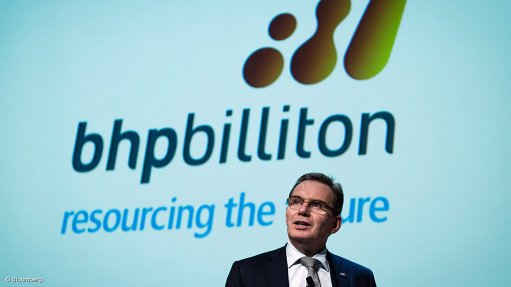
BHP Billiton CEO Andrew Mackenzie
Photo by: Bloombeg
PERTH (miningweekly.com) – Mining giant BHP Billiton on Tuesday announced that it would further cut back on spending as it downwardly adjusted its estimations for peak Chinese steel demand.
In a conference call, CEO Andrew Mackenzie said BHP had delivered productivity gains of $4.1-billion in the year ended June 30, some two years ahead of its 2017 target.
The productivity gains comprised a $2.7-billion reduction in controllable cash costs, $1.2-billion of productivity-led volume efficiencies and a further $142-million reduction in capitalised exploration expenditure.
Mackenzie noted that capital and exploration expenditure decreased by 24% to $11-billion in the 2015 financial year, adding that BHP was targeting further reductions in 2016, with capital and exploration spend to decline to $8.5-billion in 2016 and then to $7-billion in 2017.
Unit costs were down across all of BHP’s remaining operations, following the demerger of South32. The miner reported that unit costs were down by 31% at the Western Australian iron-ore operations, by 23% at Queensland Coal and by 8% at the Escondida copper operations, while costs at the Black Hawk petroleum operation fell by 19%.
“The success of our productivity initiatives generated strong cash flows, which supported our dividend commitment, funded continued investment in growth and enabled a reduction in net debt, despite the dramatic fall in commodity prices,” Mackenzie added.
“And while we recorded a sector-leading earnings before interest, taxes, depreciation and amortisation (Ebitda) margin of 50%, we will cut costs further and exercise our growing capital flexibility to improve our competitiveness and support our progressive dividend policy through the cycle.”
Mackenzie pointed out that, despite the company’s continued focus on lowering costs, this initiative would not impact growth plans, as improved productivity was expected to stretch the capacity of existing operations to increase volumes, at low cost.
As an example, unit costs for iron-ore production from the Pilbara were expected to fall from the $19/t in 2015 to $15/t in 2016, while Queensland coal costs would reduce from the $65/t in 2015 to $61/t.
“Beyond this, we continue to reduce development costs within our project portfolio. However, we remain focused on value and will only approve projects when the time is right,” Mackenzie said.
The further focus on cost efficiencies comes as BHP lowered its predicted Chinese peak steel demand to between 935-million tonnes and 985-million tonnes in the mid-2020s. This was down from a previously predicted one-billion tonnes by 2025.
Mackenzie predicted that commodity prices, especially those for iron-ore and metallurgical coal, would remain subdued over the short term, resulting in the curtailment of high-cost operations.
However, with the continued emergence of the Chinese economy, BHP remained positive on the overall outlook for the market.
Meanwhile, BHP on Tuesday reported a 47.1% drop in attributable profit to $7.1-billion for the year under review, compared with the $13.4-million reported the year before.
Profits from continuing operations declined by 61.7% to $8.6-billion for the 2015 financial year, while underlying Ebitda declined by 27.9% to $21.8-billion, as commodity prices tumbled.
Revenues declined from $56.7-billion in 2014 to $44.6-billion in the year under review.
An impairment charge of $2-billion was realised on the Onshore US assets, with the gas-focused Hawkville field accounting for a majority of this write-off, reflecting its geological complexity, product mix, acreage relinquishments and amended development plans.
A further $290-million impairment charge was recorded for the Nickel West assets.